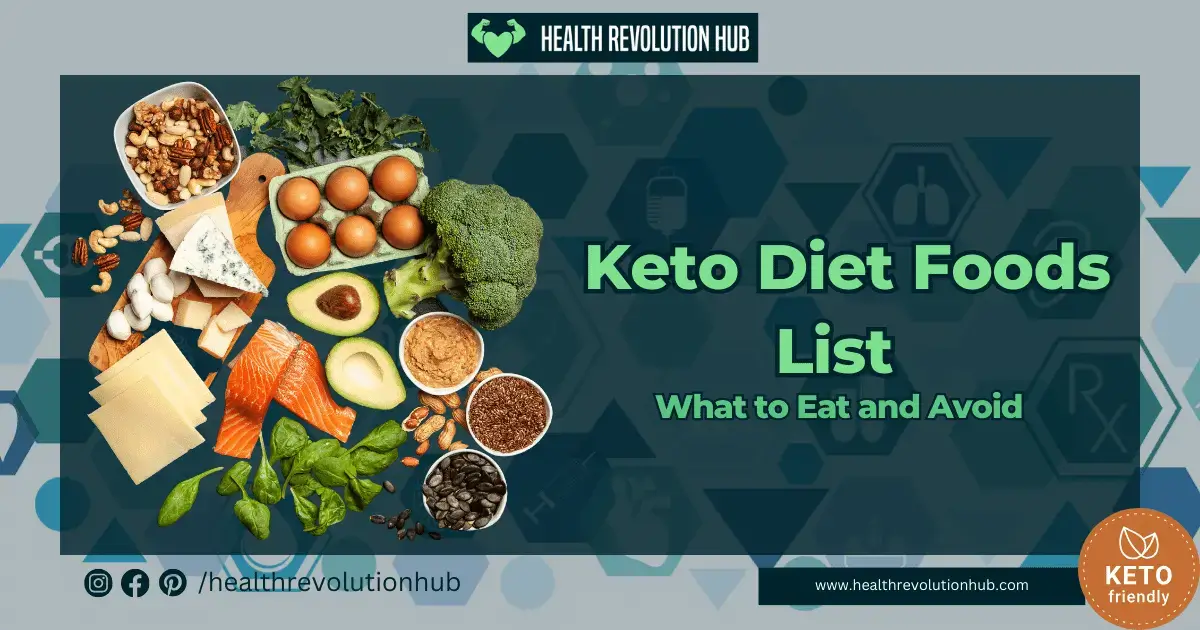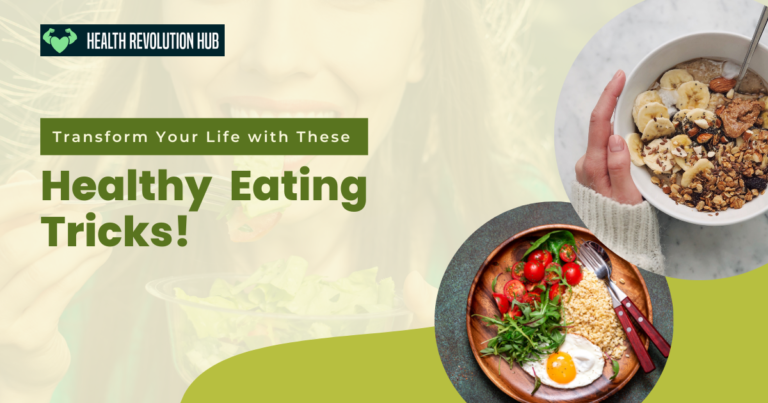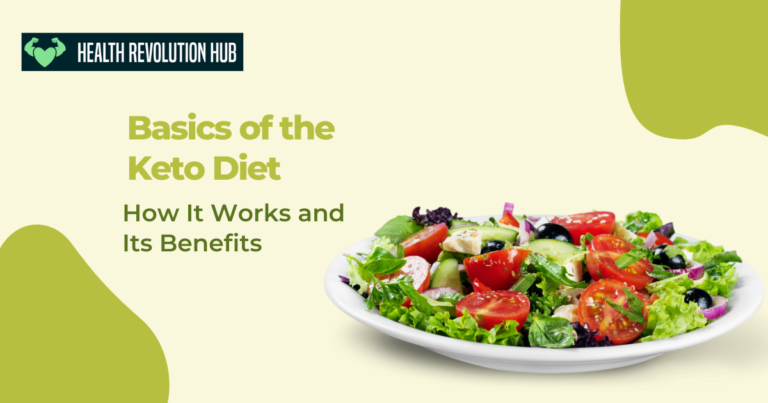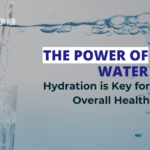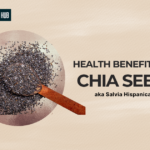Introduction
In the pursuit of ketosis, choosing the right foods is essential for success on the keto diet. While the diet encourages high fat and low carbohydrate intake, there are certain foods that can sabotage your progress. In this article, I will reveal 5 foods to say no to on the keto diet, helping you make informed choices for maximum results.
Top 5 Foods To Say No To On The Keto Diet
First on the list are sugary treats and desserts.
Next up, grains and starchy vegetables should be avoided.
Additionally, processed and packaged foods.
Furthermore, fruits, especially those high in natural sugars.
Lastly, alcohol is a big no-no on the keto diet.
By avoiding these 5 foods, you can stay on track with your keto goals and maximize the benefits of the diet. So, let’s dive in and explore why saying no to these foods is crucial for achieving ketosis.

Understanding the Keto Diet
At its core, the keto diet is a low-carb, high-fat eating plan that triggers a metabolic state called ketosis. In this state, your body shifts from using glucose as its primary fuel source to utilizing fats for energy.
By drastically reducing carbohydrate intake, typically to less than 50 grams per day, ketosis is achieved.
The keto diet offers numerous health benefits beyond weight loss.
Research suggests that this eating plan may enhance brain function, increase energy levels, and improve insulin sensitivity.
Additionally, individuals with certain medical conditions, such as epilepsy, may find the keto diet beneficial in managing their symptoms.
Foods to Avoid on Keto
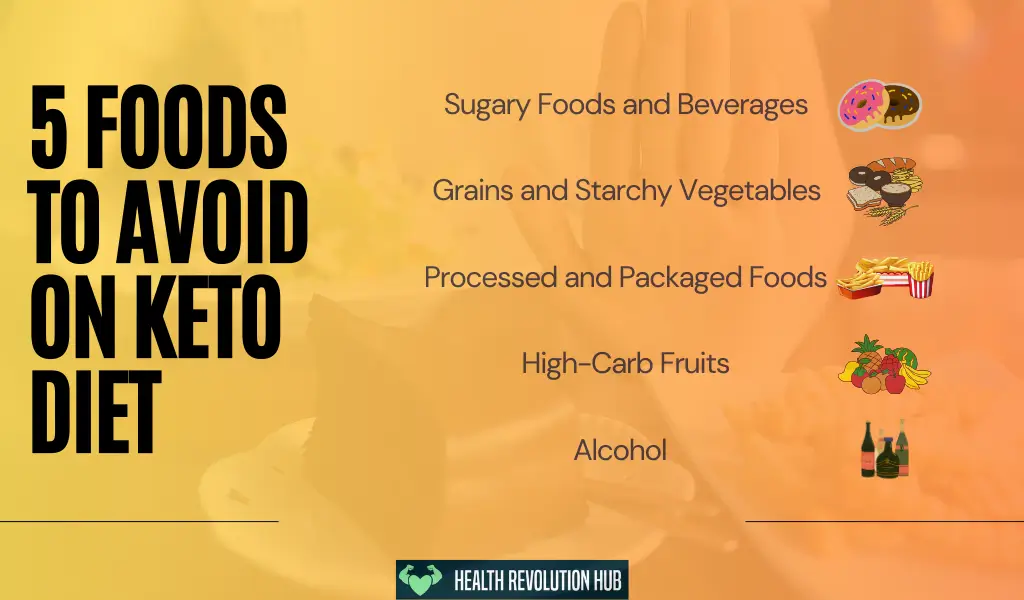
Sugary Foods and Beverages
One of the key principles of the keto diet is to minimize sugar intake. This means steering clear of sugary foods and beverages. These high-carb treats can quickly derail your progress on the ketogenic diet. Not only do they spike blood sugar levels, but they can also lead to cravings and hinder fat-burning.
Some common sugary foods and beverages to avoid on the keto diet include:
-
Soda and other carbonated drinks
-
Fruit juices and smoothies
-
Candies, chocolates, and sweets
-
Pastries, cakes, and cookies
-
Ice cream and other sugary desserts
By eliminating these sugar-laden choices, you’ll be able to maintain stable blood sugar levels and stay in ketosis, which is essential for achieving optimal results on the keto diet.
Grains and Starchy Vegetables
Another category of foods to avoid on the keto diet includes grains and starchy vegetables. These carb-heavy options can quickly add up and disrupt your body’s fat-burning metabolism. By minimizing or eliminating grains and starchy vegetables, you’ll ensure that your carbohydrate intake remains within the recommended range for ketosis.
Common grains and starchy vegetables to avoid on the keto diet include:
-
Wheat and wheat-based products (bread, pasta, cereal)
-
Rice and rice-based products
-
Corn and corn-based products
-
Potatoes, sweet potatoes, and other root vegetables
-
Legumes, such as beans, lentils, and chickpeas
It’s essential to note that even whole grains, often perceived as healthier options, can hinder ketosis due to their carbohydrate content. By swapping these carb-heavy foods with keto-friendly alternatives, you can continue to enjoy a satisfying and varied diet while staying in ketosis.
Processed and Packaged Foods
Processed and packaged foods are notorious for their high carbohydrate content, often in the form of added sugars, flour, or preservatives. To maintain ketosis and optimize health while following the keto diet, it is essential to limit or avoid these food choices.
Examples of processed and packaged foods to say no to on the keto diet include:
-
Chips and crackers
-
Breakfast cereals
-
Packaged snacks
-
Granola bars and energy bars
-
Frozen meals and dinners
-
Instant noodles and pasta
By steering clear of processed and packaged options and opting for whole, real foods, you’ll not only support weight loss and overall health but also reduce your intake of hidden carbohydrates and unhealthy additives.
High-Carb Fruits
While fruits are a natural source of vitamins and minerals, many varieties are high in carbohydrates, making them unsuitable for the keto diet. It’s crucial to be mindful of your fruit choices and opt for lower-carb alternatives. By selecting fruits lower in sugar and carbohydrates, you can still incorporate their nutritional benefits while adhering to the principles of the ketogenic diet.
Fruits to avoid on the keto diet due to their high carbohydrate content include:
-
Bananas
-
Grapes
-
Mangos
-
Pineapple
-
Oranges
Instead of these high-carb fruits, consider incorporating low-carb options like berries (strawberries, blueberries, raspberries), avocados, and lemons into your diet. These alternatives offer a lower carbohydrate impact while providing essential nutrients and fiber.
Alcohol
Alcohol might not be a good choice for you on the keto diet because alcohol can slow down your progress in maintaining ketosis.
Here are some other reasons you should avoid alcohol on the keto diet
Dehydration
Consumption of alcohol can lead to dehydration while on a keto diet maintaining fluid balance is essential.
Empty Calories
Alcohol is calorie-dense, providing 7 calories per gram, about the same as fat (9 calories per gram), and more than carbohydrates and protein (each 4 calories per gram).
Alcohol consumption can contribute to excess calorie intake, which can make it difficult to lose weight on a keto diet.
Alternatives for Keto-Friendly Eating
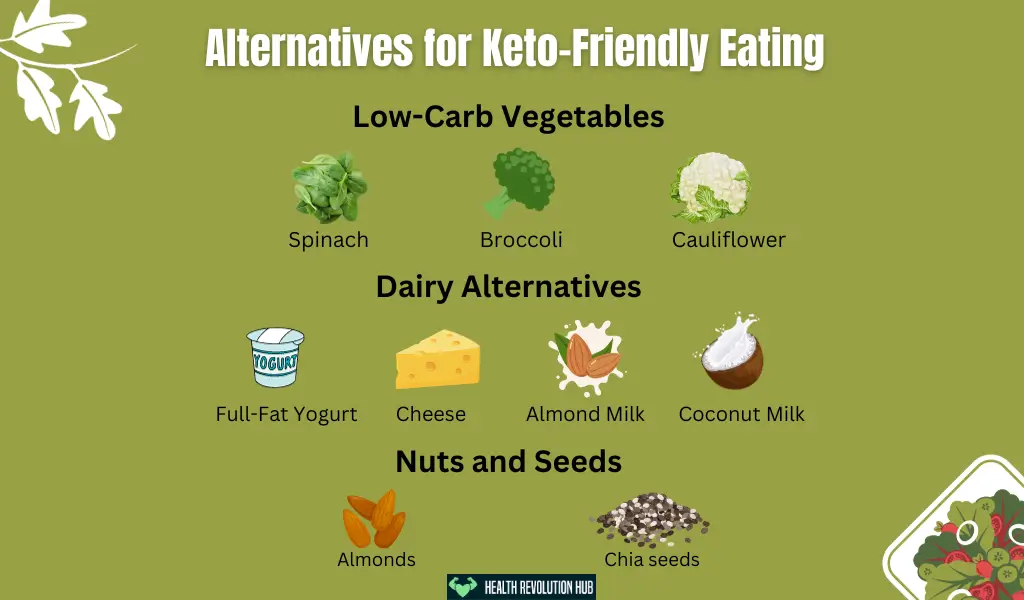
Now that we’ve covered the top 5 foods to avoid on the keto diet, let’s explore some alternatives for keto-friendly eating. While certain foods are off-limits, the keto diet offers a wide range of delicious and nutritious options that will keep you satisfied and on track
C. Low-Carb Vegetables
Non-starchy vegetables are excellent additions to a keto meal plan as they are low in carbohydrates and high in fiber, essential for maintaining digestive health. Incorporate the following vegetables into your diet:
- Spinach: This leafy green vegetable is packed with vitamins and minerals while being extremely low in carbs. Spinach is an excellent choice for keto. It’s particularly rich in iron and magnesium.
- Broccoli: A versatile vegetable, broccoli is low in carbs and rich in fiber and antioxidants.
- Cauliflower: A great alternative to high-carb foods, cauliflower can be used to create keto-friendly versions of rice, pizza crust, and mashed potatoes.
Including these low-carb vegetables in your meals not only provides essential nutrients but also adds variety and flavor to your diet.
D. Dairy and Dairy Alternatives
Dairy products can be consumed on the keto diet, but it is important to choose full-fat options to maintain the desired macronutrient balance.
Full-Fat Yogurt: Full-fat yogurt can be enjoyed in moderation on keto. It is a source of probiotics and calcium.
Cheese (in moderation): Cheese provides calcium and protein but should be eaten in moderation due to its calories and saturated fat.
Unsweetened Almond Milk: A low-carb alternative to traditional milk, almond milk is keto-friendly and offers a milder flavor.
Coconut Milk: Coconut milk is rich in healthy fats and can be used in cooking and baking to add a tropical twist to your keto dishes.
However, be mindful of hidden carbs in certain dairy products, as they can hinder ketosis.
E. Nuts and Seeds
Nuts and seeds are convenient and portable snack options on the keto diet, providing healthy fats, fiber, and essential nutrients. Consider incorporating these keto-friendly options:
- Almonds: Packed with healthy fats and vitamin E, almonds can be enjoyed in moderation as a satisfying snack.
- Chia seeds: These tiny superfoods are rich in omega-3 fatty acids, fiber, and antioxidants.
Remember to exercise portion control with nuts and seeds, as they are calorie-dense and can contribute to excess calorie consumption if not consumed mindfully.
What to Eat On Keto Diet 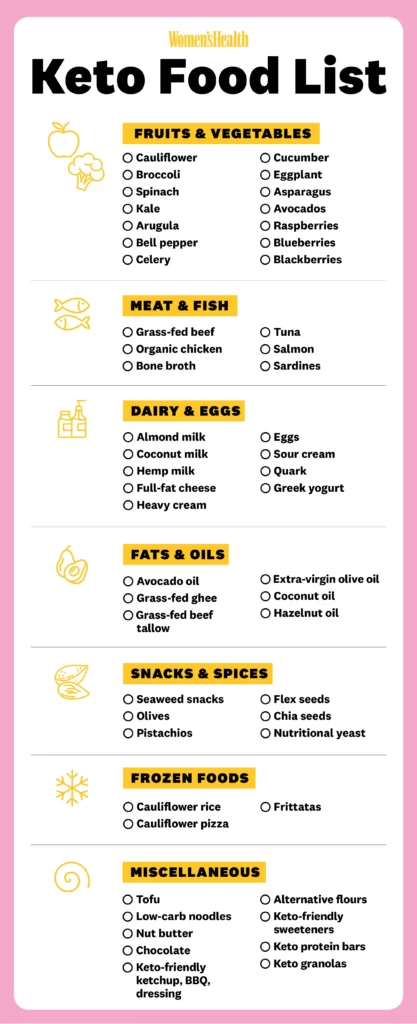
A. Healthy Fats
Incorporating healthy fats into your keto foods list is crucial for both satiety and overall health. Some excellent sources of keto-friendly fats include:
- Avocado:
Avocado is a keto superstar because it’s rich in heart-healthy monounsaturated fats. These fats not only provide a steady source of energy but also help you feel full and satisfied. Additionally, avocados are packed with fiber and essential nutrients like potassium and vitamins C, K, and B6, which support overall health on your keto journey, avocados provide a creamy texture and a myriad of health benefits.
- Coconut oil: Rich in medium-chain triglycerides (MCTs), coconut oil is easily digested and rapidly converted into ketones by the liver, providing a quick and efficient source of energy for your brain and body.
- Olive oil: Known for its heart-healthy properties, extra virgin olive oil is an excellent source of monounsaturated fats and antioxidants.
-
Grass-Fed Butter: Rich in healthy saturated fats, grass-fed butter adds a creamy and hearty touch to your keto meals while providing essential nutrients like vitamin K2.
Including these healthy fats in your meals not only adds flavor but also aids in maintaining ketosis, supporting brain function, and reducing inflammation.
B. High-Quality Proteins
While protein intake should be moderated on the keto diet, it is still essential to consume high-quality sources to provide necessary amino acids and support muscle health. Recommended sources of protein include:
- Fatty fish: Salmon, mackerel, and sardines are rich in omega-3 fatty acids and provide valuable protein, which have anti-inflammatory properties and are beneficial for heart and brain health.
- Poultry: Chicken and turkey are lean sources of protein that can be enjoyed on the keto diet.
- Lean beef: Opt for grass-fed, organic beef, as it contains higher levels of beneficial fats like omega-3s.
Protein plays a vital role in repairing and building tissues, boosting metabolism, and promoting satiety.
The Keto Diet Macronutrient Ratios
To successfully achieve ketosis, it is essential to understand the macronutrient ratios that constitute the keto diet.
While the exact macronutrient ratios can vary, a common guideline for the keto diet is to consume approximately 70-75% of calories from fat, 20-25% from protein, and only 5-10% from carbohydrates. This composition ensures that the body remains in a state of ketosis and efficiently burns fat for fuel.
These ratios typically involve consuming high amounts of healthy fats, moderate protein, and restricting carbohydrate intake to a minimum.
This distribution of macronutrients ensures that your body is deprived of glucose, forcing it to rely on fats for energy production.
Consuming ample fats helps keep you satiated and provides a steady source of fuel for your body and brain, while the moderated protein intake maintains muscle mass.
Meal Planning on Keto
A. Sample Keto Meal Plan
To simplify your journey on the keto diet, here is an example of a one-day meal plan:
-
Breakfast: Scrambled Eggs with Spinach and Feta Cheese: This breakfast is packed with protein and healthy fats to give you energy throughout the morning. A side of avocado: Adding avocado provides extra healthy fats and fiber, making your meal more satisfying.
-
Snack: Handful of almonds.
- Lunch: Grilled Chicken Salad with Mixed Greens and Olive Oil: A salad with lean protein and a drizzle of olive oil is a nutritious and keto-friendly lunch choice.
-
Dinner: Baked Salmon with Roasted Broccoli and Cauliflower: Fatty fish like salmon provide omega-3s, while broccoli and cauliflower are low in carbs and high in fiber and nutrients. salt
- Snack: Celery sticks with almond butter.
- Dessert: Sugar-free Greek yogurt with a sprinkle of chia seeds and berries.
B. Tips for Successful Meal Planning
To ensure successful meal planning on the keto diet, consider the following tips:
- Prioritize meal preparation: Dedicate time each week to prepare and portion your meals in advance, ensuring you always have keto-friendly options readily available.
- Practice portion control: While the keto diet allows for liberal fat intake, it is important to manage portion sizes to maintain a calorie balance.
- Track macros and calories: Utilize technology or food-tracking apps to monitor your macronutrient and calorie intake, ensuring you stay within your desired ranges.
By incorporating these strategies, you can navigate the keto diet with ease and reach your health goals more efficiently.
Staying Hydrated and Supplements
A. The role of water in the keto diet
Staying properly hydrated is crucial on the keto diet, as it helps support various bodily functions and assists in maintaining electrolyte balance. Drinking adequate water can also help alleviate potential side effects of the diet, such as the keto flu.
B. Suggested supplements to consider on keto
Supplements can benefit the keto diet, particularly in supporting electrolyte balance and ensuring adequate fat intake. Consider these supplements:
- Electrolytes: Due to reduced carbohydrate intake, the keto diet may cause electrolyte imbalances. Adding electrolyte supplements or consuming electrolyte-rich foods can help maintain proper hydration and minimize side effects.
- MCT oil: Medium-chain triglyceride (MCT) oil is a popular supplement among keto dieters. It can be added to meals or beverages to boost fat intake and support ketosis.
It is important to consult with a healthcare professional before starting any new supplements to ensure they align with your specific needs.
Conclusion
In conclusion, the keto diet can offer numerous benefits for weight loss and overall health if approached correctly. Understanding the types of foods to eat and avoid, planning meals in advance, and staying hydrated are essential for success on this diet. However, it is crucial to consult with a healthcare professional before embarking on this dietary journey, especially if you have any underlying medical conditions or concerns.
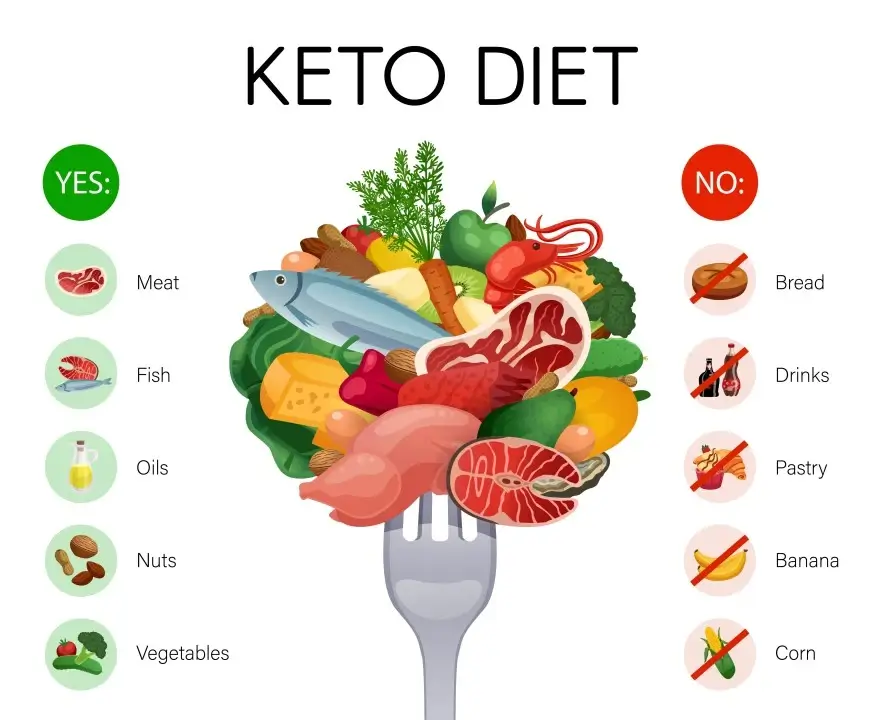
Remember, the keto diet is not a quick fix but a lifestyle change that requires dedication and consistency. By expanding your knowledge through additional resources, such as keto recipes, meal plans, and informative books or websites, you can enhance your understanding and make informed decisions about your dietary choices.
You can also read
Related Topics Keto Snack Ideas
Common Mistakes to Avoid on the Keto Diet

